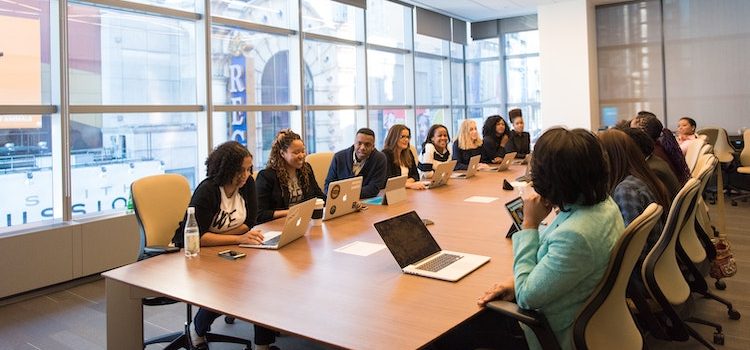

This article gives you a glimpse of what you can learn with Shortform. Shortform has the world’s best guides to 1000+ nonfiction books, plus other resources to help you accelerate your learning.
Want to learn faster and get smarter? Sign up for a free trial here .
Do you often walk away from a meeting feeling like you’ve wasted precious time? Does your agenda often get hijacked by people rambling or going off-topic? Have you ever left a 2-hour meeting feeling like you could have gotten just as much done in 30 minutes?
If any of this sounds relatable, you need to understand the best practices for meetings. This guide will explore why meetings are so dreaded and, more importantly, what you can do about it.
Keep reading for a guide to the best practices for meetings that every leader should follow.
Meetings Are the Lifeblood of an Organization
Meetings are the lifeblood of an organization—they decide the direction of the company. They also determine, in part, what people will be working on, how happy they are at work, how productive their work environment is, how much money they make, and how long their hours are.
But meetings often seem useless and too long. This presents a paradox—how can you make meetings productive when your staff views them as pointless? The answer is to make meetings better.
Why People Resent Meetings
Company meetings are often the least-looked-forward-to part on both leaders’ and employees’ agenda. In his book Death by Meeting, Patrick Lencioni discusses three reasons for this:
Reason #1: No Drama
Meetings are tedious. Given that most people sitting through meetings have other work that they could be doing, this is a huge issue, and it makes most employees resent meetings as a waste of their time. Meetings are tedious because there is no drama or tension in most meetings. In fact, most meeting leaders skirt tension if it exists.
Reason #2: Poor Structure
Meetings are unproductive. They don’t yield any results that make people’s jobs easier or help the company make a big decision, so again, employees begin to resent them. This is because meetings are unfocused. People talk about various issues that don’t relate to one another. Most issues get short shrift while the team discusses others for far too long.
Reason #3: Too Few Meetings
In general, if there are too few meetings, executives spend most of their time answering questions about logistics. In a big company, this can entirely consume an executive’s day. So these four types of meetings can actually significantly reduce meeting-like logistical activity during the rest of the day. If everyone gets on the same page, things will run much more smoothly.
Best Practices for Meetings
If you can relate to the above problems, here are some best practices for better meetings.
Add an Engagement Factor
As mentioned, one of the reasons employees resent company meetings is because meetings are boring—they lack drama. There are three ways to spice up your meetings:
Find the Hook
In every good movie, conflict starts within the first ten minutes. This is called the “hook”—it’s what draws people into the movie and makes them want to keep watching. A good meeting works the same way. A hook can take many forms, but it should explain the stakes. As the meeting leader, explain that the company is under threat, or that it’s struggling to make a dent in a new market, or that a bad decision could lead to these problems. Or, if you don’t want to start on a negative note, explain how a good decision could make life better for employees, clients, or the world.
Find Conflict
After you’ve explained the stakes, look for disagreement. If there’s a group of reasonably smart people discussing an issue that they all care about (because of the hook), they’ll disagree on at least a small part of it. If you hear disagreement or even see on someone’s face that they’re unhappy with what’s going on, explore that.
Tell the team that you want conflict in meetings. However, people may still feel uncomfortable attacking their colleagues whom they respect. As a meeting leader, remind the team that what they’re doing is positive. Just a little bit of positive reinforcement goes a long way toward resolving tensions that could otherwise become personal and encouraging participants to have different opinions.
Celebrate Achievements
Another way to make team meetings more engaging is to take time to publicly acknowledge individuals for their recent good work. For example, when you are discussing a project, take time to reward the individual employees who made it happen with positive feedback.
You can also start meetings with round robins of people sharing what they liked about a teammate. Start the day with five pennies in your pocket, and transfer a penny to the other side once you’ve given positive feedback. Set alarms to remind yourself to give feedback.
Make Meetings More Productive
Meetings are often viewed as a waste of time because…they often are. Specifically, meetings are unproductive when they lack focus and are poorly structured.
Usually, meetings work as follows. The boss schedules them for two hours. Before the meeting, the leader sends out a disparate agenda that includes somewhere between four and seven items to discuss. She solicits feedback on the agenda but gets none. The first couple of topics (not necessarily the most important) take up the lion’s share of the two hours, and the team rushes through the rest. The team makes no decisions and everyone leaves disappointed and defeated, if not outright angry.
These meetings are like a stew filled with leftovers. The team chucks everything into the pot, without much regard or care for what’s going on there. To prevent this from happening, set an agenda centered on the specific problem to be solved. Having a plan is one of the best practices for meetings.
Creating an agenda forces you to consider what the purpose of a meeting is, how it will be structured, and why it matters to the team. Furthermore, communicating the agenda ahead of time lets the team prepare, then stay on track during the meeting.
Meeting Agenda Best Practices
- Get agenda topics from the team, then decide on what topics will be in the meeting.
- Make clear what the goal of discussing each topic should be.
- Make clear the structure of the discussion—how much time each person gets, who leads the discussion, and how the decision will be made (if any).
- Share the agenda with the attendees so they can prepare and know what to expect.
- Run the meeting as proposed in the agenda.
- De-brief at the end of the meeting on what could have gone better.
In more detail, here’s how to create a great meeting agenda:
1) Ask people attending the meeting what they want to discuss and why. This lets you choose meeting topics that are relevant for all those involved. You don’t need to include all items you receive, but if you omitted a person’s suggestion, explain why to them.
2) Choose topics that are relevant to those in the meeting. If you choose irrelevant topics, attendees will disengage. What topics really need the whole team to discuss and solve?
3) Format topics as questions to answer. Don’t list an agenda item as “office lease.” This has an unclear purpose and doesn’t let people prepare effectively. Instead, write, “should we renew this year’s office lease?” This has a much clearer purpose, and it becomes clear when the meeting answers the question satisfactorily.
4) For each topic, decide the purpose of the meeting: to share information, advise on a decision, or make a decision. People who are unclear about the purpose of the meeting behave unproductively—someone who incorrectly thinks they are responsible for advising a decision will volunteer unhelpful information.
If the purpose is to make a decision, then make clear how the decision will be made. For example: “Ideally, we decide with a supermajority of over 75%. If we can’t achieve this at the end of 30 minutes, I will make the final decision within the next day and share my reasoning.”
5) Outline the process for discussing each topic. This gives a clear sequence to keep people in sync. For example: “1) We’ll introduce the topic for 5 minutes. 2) Each team member can speak for a maximum of 2 minutes for their viewpoints. 3) We’ll spend 10 minutes resolving theoretical disagreements. 4) We’ll spend 15 minutes on possible concrete solutions. 5) We’ll end with 5 minutes of an action plan and assigning tasks.”
6) Budget the time for each topic based on the process. By having a clear process, it should be clear that a complicated issue involving 20 people can’t be resolved within 10 minutes.
7) Designate a leader for each topic. This may not be a team member and not the leader of the overall meeting. The topic leader should prepare accordingly and lead the discussion process, as prepared above.
8) Write how attendees should prepare for each topic before the meeting.
9) Start the meeting with room to modify the agenda. Recent news may change the focus of the meeting.
10) End the meeting with a debrief. What went well this meeting? What can we improve for future meetings? Did we follow the agenda as designed? Could the agenda have been better designed? At the next meeting, review these results as the second agenda item.
Choose the Appropriate Meeting Frequency and Length
Because company meetings are both boring and inefficient, the leader often attempts to schedule fewer of them, which makes them even more inefficient.
Patrick Lencioni proposes the following best practices for meeting frequency and length, based on their purpose and the topic of discussion.
The Check-In
This is the shortest meeting. It happens for five minutes at the beginning of each workday and is purely logistical: Who is here, who isn’t, and what everyone is working on today.
Never cancel the check-in meeting and keep it to five minutes at most. Don’t address anything beyond simple logistics here—other, larger problems can wait for the other meetings. People don’t even need to sit down for the check-in.
The Tactical
This meeting happens every week or every other week and lasts for around an hour. 45 minutes is a shorter tactical and 90 minutes is a longer one.It starts with everyone going around and explaining, in under a minute, what they’re working on. After everyone knows what’s going on with everyone else, you and anyone you deputize gives updates on some larger logistical issues—how does the budget look, is the team hitting their sales goals, what is the team spending on advertising, and on from there.
Only then does the team create an agenda—this way, the agenda is based on what is actually going on at the company as reported by everyone involved. Address short-term tactical challenges at this meeting, like whether to increase advertising for the month or whether to hire someone new. This meeting is meant to resolve and clarify short term obstacles to the company.
The Strategic
This meeting is about large-scale strategy decisions. It happens every month or so and lasts anywhere from two to four hours. Only the most salient questions are at issue in the strategic meeting—limit the agenda to two to three big questions. A lot of strategic questions will likely come up in the weekly tactical meetings, such as whether to expand into a new market or who advertisements are targeting, but prioritize the strategic questions they deem most important.
Additionally, everyone must come prepared with research. Conflicts, as previously discussed, are the lifeblood of these meetings, but if people arguing with one another don’t have data to back up their points, the conflict isn’t productive.
The Review
The final meeting is the review, which takes place about once a quarter off-site. The review meetings involve long, important discussions about the direction of the business. This is where executives can get together and discuss the direction of their business or new challenges to their industry. Additionally, executives should assess their own performance and the performance of important employees.
The review meetings aren’t too structured—the team can go into the off-site review with a basic understanding of some topics that they want to cover, but they don’t need a comprehensive agenda or a cutoff point.
Conclusion
Company meetings are crucial to the success of your organization. Meetings ensure everyone in the company is on the same page as to where the organization is heading. They help strengthen employee relationships and create a sense of collective belonging,
However, company meetings are often boring and ineffective. Creating effective meetings with the help of the above best practices for meetings will help your employees look forward to—not dread—them.
Recommended Reading on Best Practices for Meetings
Want to learn more about best practices for meetings? Here are some reading suggestions that might be up your alley:
Death by Meeting
Death By Meeting uses the parable of a struggling executive to suggest best practices for meetings every leader should follow. Learn why attempting to defuse tension among employees is a mistake, and how injecting more drama into four unique types of meetings is the key to a more passionate, engaged, and successful team.
Indistractable
In today’s tech-dependent, app-centered, notification-ruled world, it’s easier than ever to get distracted from what’s really important—your values, your relationships, and your work. In Indistractable, Nir Eyal develops a four-part model for gaining the modern-day superpower of “indistractability.”
You’ll learn how your distractions start internally, why your schedule should be based on your values instead of tasks, how to diminish the power of external triggers in your life, and how to commit to yourself—so you can start driving your life instead of letting its distractions drive you.
Rework
Conventional wisdom says that starting a business requires outside investors, strategic plans, accountants, a board of directors, and many other “musts.” But in Rework, entrepreneurs Jason Fried and David Heinemeier Hansson explain how old-school thinking doesn’t apply in today’s new business paradigm.If you’re launching a company today, you can access online tools and technology that let you operate on a shoestring. Rework encourages entrepreneurs to reject old-school thinking, embrace simplicity, and run your company like a smart, frugal, well-oiled machine.
Carrots and Sticks Don’t Work
In Carrots and Sticks Don’t Work, Paul Marciano argues that employee engagement stems from respect. Employees don’t want to be treated like cogs in a chain. Instead, they want to feel empowered, have autonomy, receive supportive feedback, and be treated considerately. Learn what components of work people really want, and simple actions to take today to engage your team.
Creativity, Inc
In Creativity, Inc., Ed Catmull breaks down the most important factors in building and sustaining a creative culture. From removing fear from failure and protecting new ideas, Catmull explains the ways Pixar’s creative culture allowed it to grow into the animation behemoth it is today.

Want to fast-track your learning? With Shortform, you’ll gain insights you won't find anywhere else .
Here's what you’ll get when you sign up for Shortform :
- Complicated ideas explained in simple and concise ways
- Smart analysis that connects what you’re reading to other key concepts
- Writing with zero fluff because we know how important your time is






